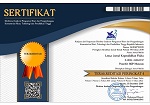Quality Analysis of Briquettes based on Waterding with Variation of Pressure and Pellet Geometry to Water Content and Value of Calories
DOI:
https://doi.org/10.33394/j-lkf.v8i2.2758Keywords:
Water Hyacinth, Briquettes, Geometry, PressureAbstract
This study is a research on water hyacinth-based briquettes which shows the calorific value of each form of briquettes. The purpose of this study was to analyze the quality of water hyacinth briquettes with variations in pressure and pellet geometry. The quality analyzed includes moisture content and calorific value. The method of making briquettes starts from charcoal, pounding, then mixing with tapioca starch adhesive. The composition of the mixture used is 90% water hyacinth charcoal with 10% tapioca starch adhesive. 4 geometric variations are used, namely, solid box, hollow box, solid tube and hollow tube with 3 pressure variations, namely, 10 PSI, 20 PSI and 30 PSI. Test results and analysis,briquettes at a pressure of 20 PSI produces a calorific value range of 91.15 - 150.14 cal / gram. The resulting calorific value is higher than the briquettes at a pressure of 10 PSI and 30 PSI with a heating value range of 93.84 - 148.79 cal / gram and 89.81 - 135.39 cal / gram. Hollow briquettes produce a calorific value range of 107.24 - 150.14 cal / gram higher than solid geometric briquettes which produce a heating value range of 89.81 - 148.79 cal / gram. So that the contribution of the results of this research is that the community makes briquettes with shape and pressure with good results shown in this study.References
Balong, S., Isa, I., & Iyabu, H. (2016). Karakterisasi Biobriket dari Eceng Gondok (Eichornia Crassipes) sebagai Bahan Bakar Alternatif. Jambura Journal of Educational Chemistry, 11(2), 147-152.
Fachry R. dkk. (2010). Mencari Suhu Optimal Proses Karbonisasi dan Pengaruh Campuran Batubara terhadap Kualitas Briket Eceng Gondok. Jurnal Teknik Kimia, No. 2, Vol. 17, April 2010.
Fatmawati, D. (2015). Pembuatan Biobriket dari Campuran Enceng Gondok dan Tempurung Kelapa dengan Perekat Tetes Tebu. Jurnal Teknik Mesin, 3(02).
Husada, T.I. (2008).Arang Briket Tongkol Jagung sebagai Energi Alternatif, Laporan Hasil PenelitianProgram Inovasi Mahasiswa Provinsi Jawa Tengah. Universitas Negeri Surakarta, Semarang.
Iis, R., Sarwono, & Ridho, H. (2009). Studi Eksperimental Karakteristik Briket Organik Bahan Baku Dari Twa Gunung Baung.
M. Afif Almu, Syahrul, Yesung Allo Padang. (2014). Analisa Nilai Kalor dan Laju Pembakaran Pada Briket Campuran Biji Nyamplung (Calophyllm Inophyllum) dan Abu Sekam Padi. Mataram. Dinamika tekhnik mesin.
Mardwianta, Benedictus. (2009). Laju Pembakaran Briket Batubara Berbentuk Silinder dengan Variasi Kecepatan Aliran Udara Pembakaran.Jurnal Angkasa Vol. 3 Mei 2011. Yogyakarta.
Moeksin, R., Comeriorensi, L., & Damayanti, R. (2016). Pembuatan Bioetanol dari Eceng Gondok (Eichhornia Crassipes) dengan Perlakuan Fermentasi. Jurnal Teknik Kimia, 22(1), 1-9.
Pangga D., Hidayatullah, M.S., Sabda, D. (2017).Pembuatan Batako Ringan dari Limbah Pengolahan Emas dengan Filler Eceng Gondok. “Epistimologi Perkembangan Kurikulum Pendidikan di Indonesia dan Implementasinyaâ€. ISBN: 978-602-61335-1-2 (211-219)
Pangga, D & Ahzan, S. (2019). Pengembangan Eceng Gondok sebagai Bahan Dasar Pembuatan Briket Sumber Energi Alternatif. Makalah disajikan dalam Seminar Nasional, FPMIPA IKIP Mataram, Mataram, 24 Agustus
Sugianto, I., Prasetya, D. S. B., & Ahzan, S. (2018). Penggunaan Eceng Gondok Sebagai Filler untuk Meningkatkan Kuat Mekanik Batako Ringan Berbahan Dasar Limbah Emas. Lensa: Jurnal Kependidikan Fisika, 6(2), 43-49.
Supatata, N., Buates, J., & Hariyanont, P. (2013). Characterization of fuel briquettes made from sewage sludge mixed with water hyacinth and sewage sludge mixed with sedge. International Journal of Environmental Science and Development, 4(2), 179.
Thabuot, M., Pagketanang, T., Panyacharoen, K., Mongkut, P., & Wongwicha, P. (2015). Effect of applied pressure and binder proportion on the fuel properties of holey bio-briquettes. Energy Procedia, 79, 890-895.
Downloads
Additional Files
Published
How to Cite
Issue
Section
License
Authors who publish with Lensa: Jurnal Kependidikan Fisika agree to the following terms:
- For all articles published in Lensa: Jurnal Kependidikan Fisika, copyright is retained by the authors. Authors give permission to the publisher to announce the work with conditions. When the manuscript is accepted for publication, the authors agree to automatic transfer of the publishing right to the publisher.
- Authors retain copyright and grant the journal right of first publication with the work simultaneously licensed under a Creative Commons Attribution-ShareAlike 4.0 International License that allows others to share the work with an acknowledgment of the work's authorship and initial publication in this journal.
- Authors are able to enter into separate, additional contractual arrangements for the non-exclusive distribution of the journal's published version of the work (e.g., post it to an institutional repository or publish it in a book), with an acknowledgment of its initial publication in this journal.
- Authors are permitted and encouraged to post their work online (e.g., in institutional repositories or on their website) prior to and during the submission process, as it can lead to productive exchanges, as well as earlier and greater citation of published work (See The Effect of Open Access).

This work is licensed under a Creative Commons Attribution-ShareAlike 4.0 International License.



